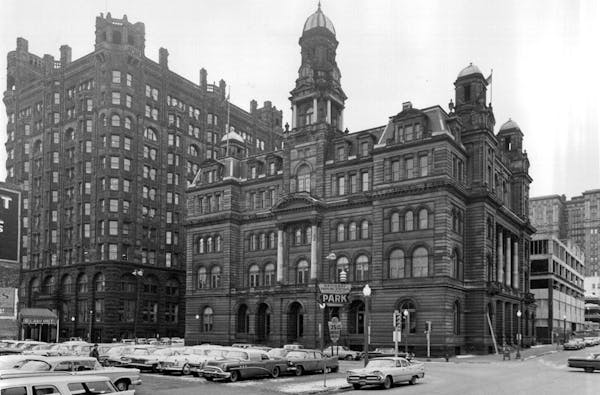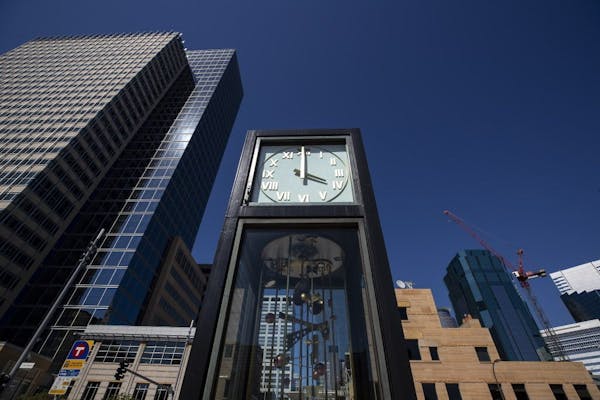In the 1880s in downtown Minneapolis, an architectural mystery unfolded.
Two early office buildings stood across Nicollet Avenue from each other, yet looked as though they might have come from different architectural planets.
One was an outlandish Gothic Revival pile that epitomized the excesses of Victorian design. The other was a glassy, stripped-down work of pre-modernism well ahead of its time.
What makes the story of these two utterly disparate buildings so unusual is that they were designed around the same time by the same architectural firm, the long-gone and little-remembered Isaac Hodgson and Sons.
Hodgson was an Indiana native who practiced architecture in his home state before relocating to Minneapolis in 1882. His firm, which at various times included two of his sons, later established offices in several other Midwestern cities, including St. Paul.
The firm's first big work in Minneapolis was the Chamber of Commerce Building, which opened in 1884 at 301 4th Av. S., where the Grain Exchange complex now stands. It was a rather bombastic example of the French Second Empire style, complete with two towers and plenty of rich detailing, none of which saved it from the wrecking ball in 1927.
But it was Hodgson's next work — a delirious Gothic Revival style office building for the Minnesota Loan and Trust Co. at 313 Nicollet Av. — that made a memorable, albeit very strange, mark on the budding Minneapolis skyline.
The seven-story building, completed in 1885, almost defies description. Suffice it to say that its sandstone facade on Nicollet was a Victorian carnival, with every one of the seven floors sporting a different pattern of windows.
At the top, the building erupted in a spiky extravaganza of pinnacles, tourelles and pediments to either side of a gawky, steep-roofed clock tower. The whole concoction was at once ridiculous and yet somehow lovable, like a really bad movie. But it didn't have a long run. The building came down in 1911, perhaps undone by what today might be called its bad optics.
Hodgson and Sons, to its eternal credit, never did anything quite like it again, but the sharp turn toward modernism the firm executed just two years later, in a building for the Bank of Minneapolis at 300 Nicollet Av., was nonetheless extraordinary.
Thoroughly modern
It was a work of radical simplicity, unlike any other building of its time in the city. A straightforward box, it was clearly inspired by contemporaneous work in Chicago, then the epicenter of innovative skyscraper design.
The building featured large windows that took up virtually all of the two main facades. Narrow stone columns separated the windows, giving the building the cagelike appearance of many skyscrapers to come.
Its structural system was also noteworthy. With its glass-filled facades and lack of heavy exterior masonry, the building must have been framed almost completely in iron or steel. If so, it would have been the first high-rise building of this type in Minnesota, and possibly one of the first in the nation.
Easy prey for urban renewal
How did Hodgson's firm go from a Victorian antique like Minnesota Loan and Trust Building in 1885 to something as forward-looking as the Bank of Minneapolis just two years later?
Possibilities abound. Perhaps a new draftsman with advanced ideas entered Hodgson's firm after 1885 and took charge of the bank project. Or maybe someone in the firm, even Hodgson himself, began looking closely at what was going on in Chicago and decided to move in that direction.
Another possibility is that the client behind the building lobbied against the usual Victorian foofaraw and insisted on something clean and simple instead.
What's certain is that Hodgson and Sons, a meat-and-potatoes outfit that produced mostly conventional designs, soon returned to its old ways, and none of its subsequent works were as minimalist or modern as the bank.
Perhaps because of its uncomplicated appearance, the bank building, later home to the Lincoln Clothing Store for many years, never drew much public attention. It was an easy target for the forces of urban renewal in the 1950s. Along with all the other buildings on its block, it came down in 1958 to make way for a new Central Library (which was in turn razed in 2002 for the present library).
A final note: Against all odds, one of Hodgson and Sons' works in downtown Minneapolis still stands. The Swinford Townhouses at 1213-21 Hawthorne Av. were built in 1886, showcasing the firm's persistent fondness for many varieties of ornament.
Larry Millett is an architecture critic and author of 14 nonfiction books and eight mystery novels. He can be reached at larrymillett.com.
Live video of man who set himself on fire outside court proves challenging for news organizations


